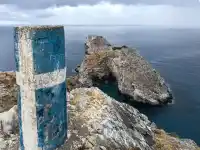Who wouldn’t want to find themselves in a country where roast pigeons fall into a mouth, wine pours down a stream, the sun shines without pause, and the only really stress is deciding whether to have another glass of red or white vine. We drive through the wine country of Alentejo, Portugal’s finest wine region, where even the biggest teetotaler will end up with a tasting glass.
It started with a subtle challenge from Lisbon. Let’s taste some really dry Portuguese wines. And so we sit in Lisbon’s Orient station, waiting for the train to take us to Évora, the historical centre of the entire region. It’s hard to believe for Slovak people, but the train arrived on time and wasn’t a minute late at its destination, Évora.
Évora
We rented a car and stayed right in the centre. We had a beautiful room with a garden and a terrace. Parking in an alley narrower than our car, I began to understand why the Portuguese prefer small Fiat 500s to three-ton SUVs. We wasted no time and visited the Enoteca Cartoux later in the evening. It’s right next to the ruins of a Roman temple.
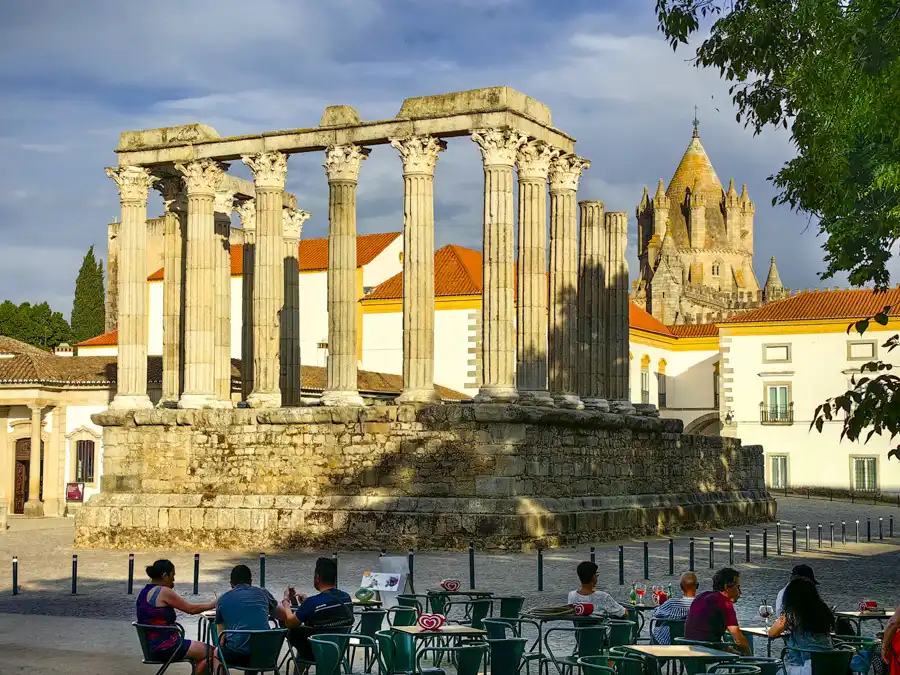
“Hello and welcome to Alentejo! Will you be tasting red, white, or rosé?” The sommelier asks. “Everything, please,” we reply with enthusiasm. Preparation is not to be underestimated. We taste the oysters, wines and tackle the flavours with a seriousness that could be compared to NASA testing rocket fuel.
After a few glasses, we begin to feel like seasoned experts. We discuss tannins, acidity and length of aftertaste with a guy who knows a thing or two about this stuff and is clearly amused by our sudden confidence. Our knowledge might be limited to ‘it tastes great’ and ‘give me another glass’, but who could blame us? Especially when we’re paying. We’re in Évora, after all! For the next three days, we’ll explore this region’s wines and beauty on the other side of Europe. After all, life is not all about work and stress but about enjoying the little things that make us happy.
Monsaraz Castle

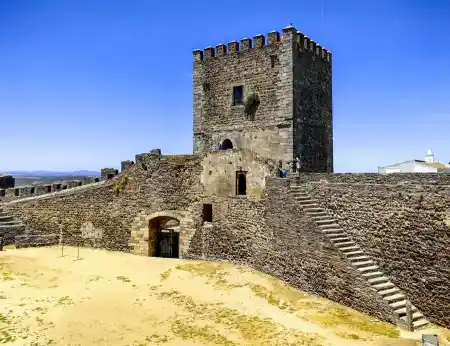

More at photogallery >
As you journey to Monsaraz, the landscape unfolds like painting-wide plains, cork trees, grazing herds, gently rolling hills and occasional mountains. Avoid highways for a more immersive experience. When you finally reach the Monsaraz Castle, the breathtaking view of the Albufeira de Alqueva Lake will leave you in awe. The beauty of this scene is beyond words.
The castle’s hillside and the lake form a unique symbiosis of history, nature, and modern ecological initiatives. The reservoir below the medieval castle is stunning, like an endless oasis of water in the desert. It is the largest artificial reservoir in Europe. The Albufeira de Alqueva stretches over more than 250 km², creating countless bays, peninsulas, and islands that offer endless possibilities for man to explore.
We are here out of season, and we are here alone. That’s good. In the narrow streets of Monsaraz Castle, we wander leisurely. It’s 35° outside, like in the blacksmith’s shed, and the sun is scorching us. In our search for shade, we also discover the Museum of the Inquisition. We walk around all the alleyways and meet four people. In the silence and emptiness, I promise myself that if I return here one day, I’ll stay at the castle in Monsaraz. Yes, that’s possible, too.
Albufeira de Alqueva



More at photogallery >
We go down to the lake. We are in the harbour, where there is only one boat and perhaps a cattle ford. You can hear the wind vibrating and the grass growing. Still, I consider that moment the most powerful experience of the day. I dream of the boat and exploring the shores of that stillness.
Those endless bays and meanders beckon me. On the other side of the lake, Spain is already there. One more short stop at a prehistoric olive orchard, and we escape to Monsaraz. The first tasting awaits us.
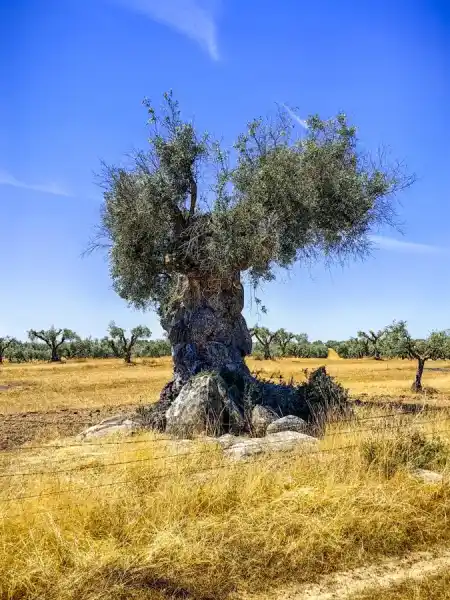
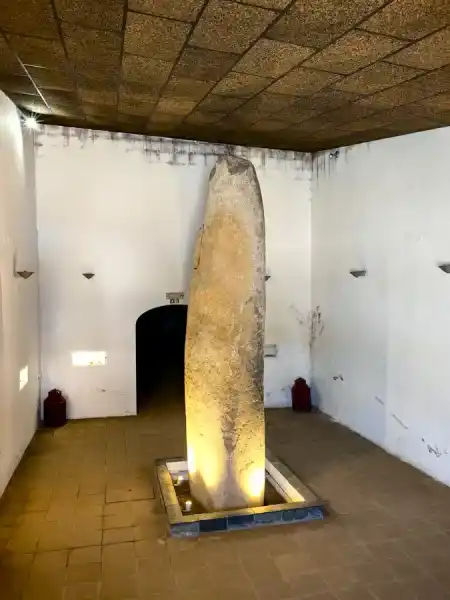

Adega José de Sousa
If someone asks me why this particular winery, I will answer: “Because I have to.” Because at José de Sousa, they make traditional wine using traditional methods in ceramic amphorae, just like the Romans did 2,000 years ago. More about the winery here.
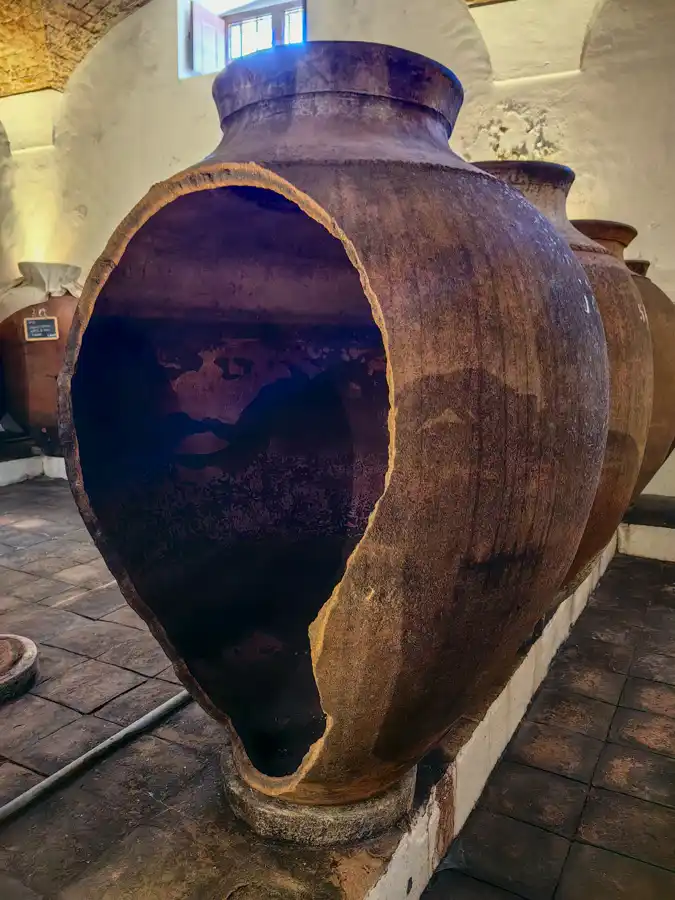
Adega José de Sousa
According to the Romans, how is wine processed using a 2000-year-old method, and how does it taste?
Estremoz
We start the second day in Estremoz. I love contrasts, so we arranged to meet in the afternoon at Herdado do Freixo, the region’s most modern winery and perhaps even Europe. But now it’s time for something else. Portugal is famous for its antiques and flea markets.



More at photogallery >
Imagine stalls laden with all sorts of things – from antique cuckoo clocks that might (or might not) still tell the right time to old gramophone records to paintings whose artistic value is directly proportional to your imagination.
“How much for that cuckoo clock?” you ask with the enthusiasm of an old salesman who looks like he might be a direct descendant of the artefact’s original owner.
“That’s not just a cuckoo clock,” the salesman replies mysteriously, “That’s the clock that used to hang in Évora Monte’s castle! At least that’s what the man who sold it to me claimed.”
Nod in agreement, engaging in a friendly chat, and making a charming attempt at negotiation. This could be you, becoming the proud owner of a ‘historic’ piece from the Saturday markets in Estremoz. And if you’re ever in doubt, just visit my son in Lisbon. He still proudly displays the piece to this day.
Carpets of Arraiolos
A short distance away, old woman sells an exceptionally well-preserved hand-woven rug, apparently from Arraiolos. Never mind that we’ll have to lug it to Lisbon. We negotiate immediately. After all, making these rugs is a complex and time-consuming process that requires great skill and patience. Each rug is hand embroidered on a cotton or jute base, using sheep’s wool dyed with natural dyes. These dyes are extracted from various plants, minerals and clay, ensuring durability and vibrant hues. The embroidery technique is known as ‘Arraiolos stitch’, a type of tapestry stitch. This stitch is the basis for creating the intricate and detailed Moorish designs that are characteristic of them. Their price is also distinctive. Even a tiny rug costs hundreds of euros; large ones typically cost several thousand.
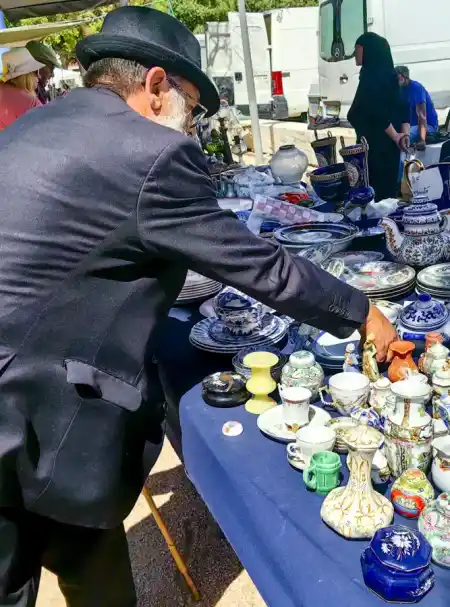
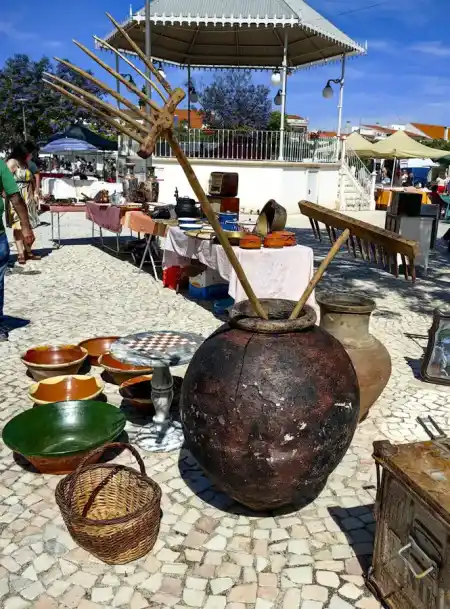
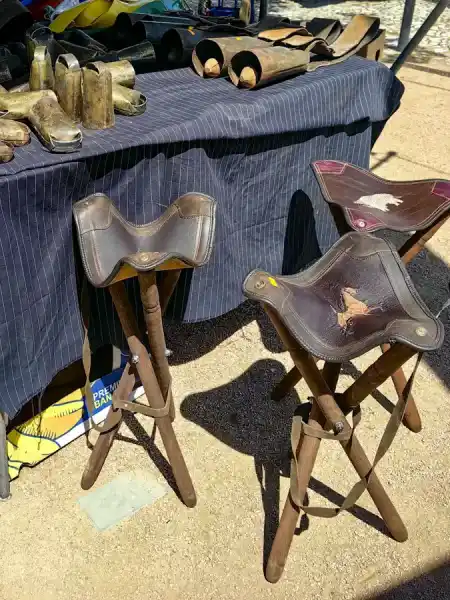
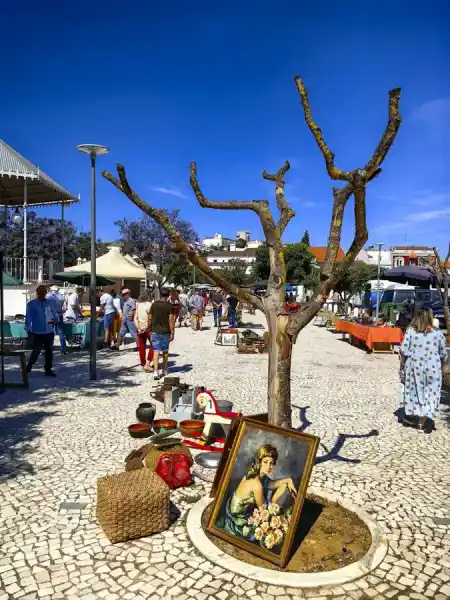
More at photogallery >
We continue to wander among the stalls. In some places, they look us over and assess that no effort is needed. In others, the vendors are trying to sell their best treasures with stories that are at least as valuable as the items. One gentleman offers an old porcelain tea service, claiming that it was used by the Queen of Portugal herself. It doesn’t matter if it’s true; the important thing is that he offered you a beautiful story.
Suddenly, a leather stall catches my eye. On a beautiful handmade tripod with embroidered leather, its owner sits and offers me, “Sit down”. I know this is a stupid, irrational decision; I’ll never pass airport security with this. Still, the price of 25 euros breaks me. I leave with a trophy.
Alentejano one star
After an hour of walking and exploring, we deserve a reward. I buy more mango, yellow melon, some old mouldy cheese and sausages for dinner. We load the carpet and tripod into the car and head to the Alentejano Hotel, where we order a pastel de nata, coffee, and a small beer. Really small. They serve me 2 dcl. While enjoying my sweet dessert, I look at the people passing by. The markets end after one, and it’s warm as hell. Each visitor takes away their own catch, certainly with a unique story.
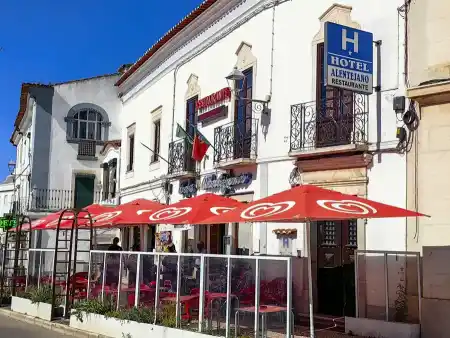
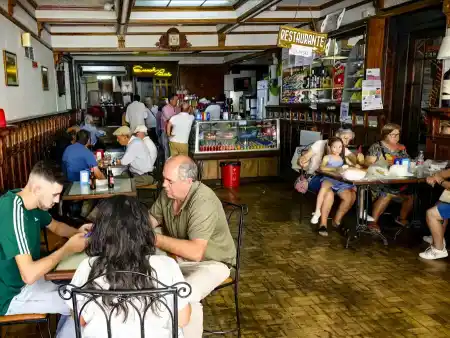
With two espresso coffees and one small beer, we leave Estremoz a little after one. I have seen many hotels boasting three, four, and five stars. But for a hotel to be proud of one star and yet full of happy local customers was a new experience for me. With plenty of time until 4 p.m., we make our way to Vila Vicosa. The village is especially famous for its marble mines, but like proper tourists, we discover the manor house first.
Vila Vicosa
If I die, the tombstone will be from here. Marble is everywhere. There’s plenty of it, even in the public toilets of a very local tavern in Esprimoz.
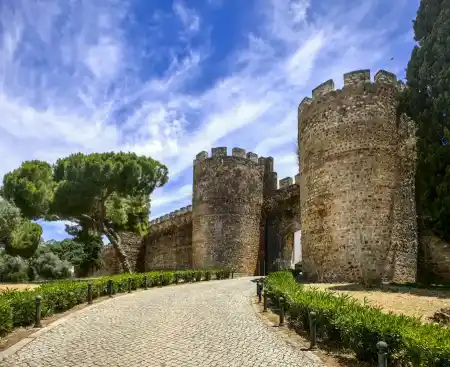
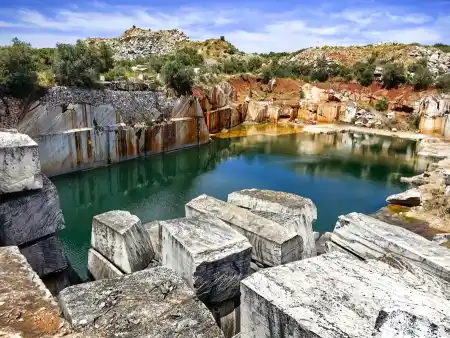

More at photogallery >
We bypass the marble museum, which is a bit of a tourist bore. But on the way to Esprimoz, we discover dozens of living marble quarries. They ooze with daily sweat and authenticity. Again, I emphasize: “If you want to discover the Alentejo, get off the main tourist routes and roads.”
Alentejo wine country
Here are some facts: The Alentejo wine region is located in the southern part of Portugal. It is one of the country’s most important and renowned wine regions and covers almost a third of mainland Portugal. It is famous not only for its wine but also for its beautiful countryside, cork trees, and historic villages.
The climate is predominantly Mediterranean, with hot, dry summers and mild winters. These conditions, together with the soil, create ideal conditions for growing vines. The soils vary, ranging from granite and shale to calcareous and loamy sand, contributing to the local wines’ richness and diversity.
The history of winemaking in the Alentejo dates back to Roman times. Many monuments from that time exist, including Roman ruins, ancient castles, monasteries, and typical white villages with narrow streets and blue windows. Évora itself is a UNESCO World Heritage Site. Today, the Alentejo is considered one of Portugal’s most innovative and dynamic wine regions. Our next tip, an ultra-modern winery near the village of Freixo, is proof of this.
Herdade do Freixo
At Herdade do Freixo, you’ll witness the epitome of an uncompromising approach. This was not just a highlight of the day, but a defining moment of the entire trip. If anyone questions why one should journey to Portugal for wine, I’ll share a personal experience. I’ll contrast the historic production of José de Sousa with the ultra-modern approach of the winemakers at Freixo, a unique blend of tradition and innovation that will leave you in awe.
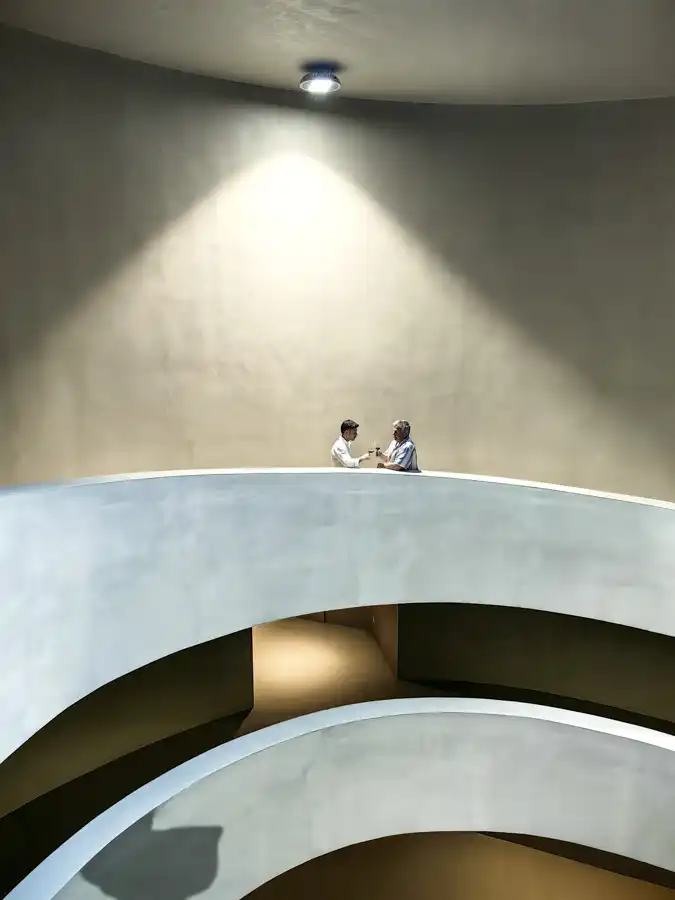
Herdade do Freixo
An ultra-modern winery in the middle of nowhere, in the heart of the Alentejo. What does wine made with ultramodern technology taste like?
Modernism and history, absolutely uncompromising contrasts in approach, technology, production, and taste, are the best reasons to visit Evora, discover the Alentejo, and taste its wines. In the area, you will find dozens, maybe a hundred, wineries with very high-quality wines and reasonable prices for Europe. Still, these two wineries represent the limits and extremes in approach.
What unites them is excellent, unmistakable wine, love of nature, local patriotism and pride in the country of origin. After all, it is not for nothing that both wineries have been producing wines since the 19th century.
Cork Forrest
On our way to the last destination of the day, Monte Évora Manor, we found our way through an ancient cork forest. We had to stop. I have nothing to add to the photos, only that it’s quiet—absolutely silent.

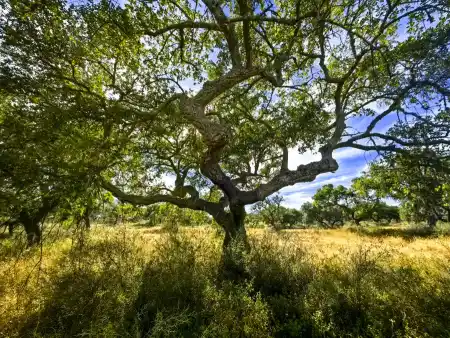
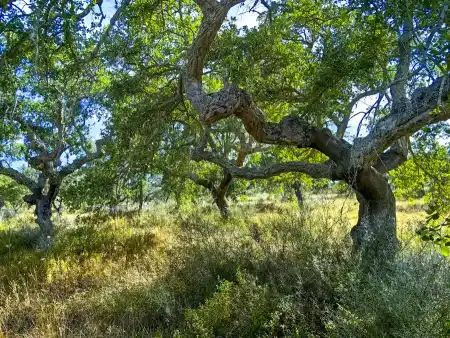
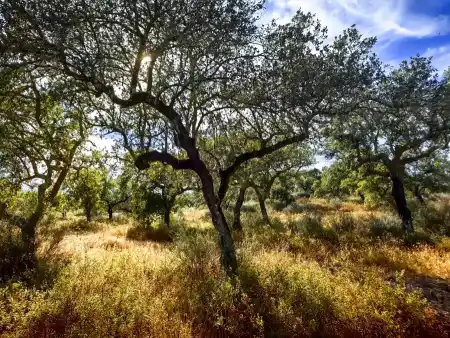
More at photogallery >
Évora Monte
And we are already climbing the last hill of the day. From the top of Évora Monte, we have a 360° view of the entire Alentejo. This is the second historic manor house to be inhabited inside the walls. We climb the walls and walk around the whole castle complex. Along the way, we see both the feeding of the chickens and the laying of bouquets of flowers on the marble tombstones of the local cemetery. This manor house also has its own cemetery.

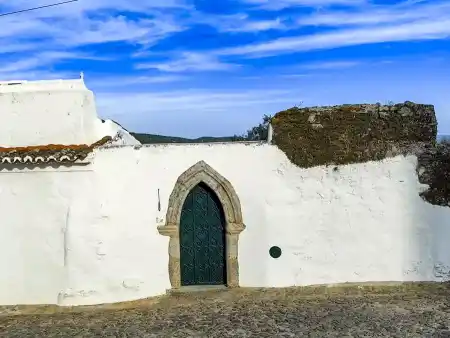

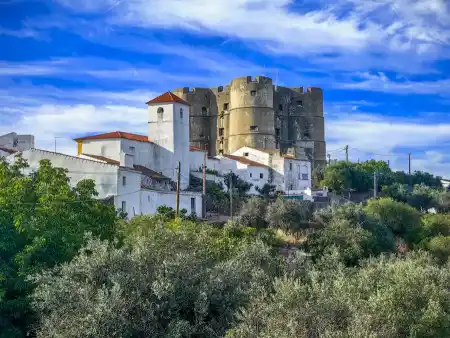
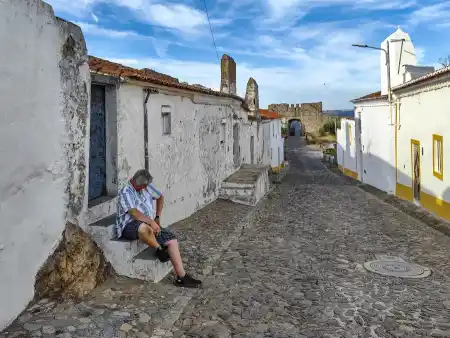
The castle, a harmonious blend of military fortress and palace architecture, is a visual masterpiece. Its most prominent feature (reminiscent of the Bratislava Castle) is the four towers connected by thick walls, creating a square inner courtyard. These towers, adorned with battlements and gunports, not only served a strategic purpose but also added to the castle’s allure. Moors, Spaniards, Portuguese, apparently, there was a lot of fighting in the Middle Ages. The entrance to the castle, marked by a richly decorated portal, leads to several halls and chambers that once served as living quarters and ceremonial rooms.
As we leave, a large caravan lurches up the hill. It must be immense freedom to park up near castle, pull up a table and chairs and admire the sunset over a bottle and some good cheese. We are ungratefully jealous and trundle off to the garden in Évora instead.
Almendres Cromlech
On the third day, we went in the opposite direction. We cross the village of Guadalupe to Almendres Cromlech and then to the castle of Montemor-o-Novo. Our third wine tip was the family winery Quinta da Plansel. However, with Dorine, the timing didn’t work out for us this time. What the heck, Sunday. Next time.
If anyone advises you to go to the Cromlech for a car trip, thank you politely. Check out our photos and forget it. You won’t break axles of your car and save yourself a trip to the psychiatrist. You just don’t experience that kind of broken road and stress that easily. The 20 km drive to Guadalupe took us ten minutes. The 6 km stretch to Almendres Cromlech took us over two hours. If we had walked, we would have been there sooner. If we hadn’t driven, we wouldn’t have had a heart rate over 130 and stress on the verge of a stroke. It wasn’t the megalithic Cromlech (4000 years old BC) that was the experience; it was the journey. And instead of mysticism and esoterica, we meditated mainly on the state of the left half-axis of our Fiesta.

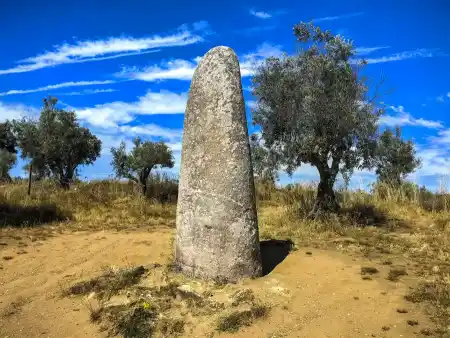
More at photogallery >
Almendres Cromlech is also known as the “Portuguese Stonehenge”. It is one of the Iberian Peninsula’s most prominent and best-preserved megalithic complexes. It dates back to the Neolithic period, approximately 6000 to 3000 BC. This means that this megalithic complex is older than Stonehenge itself. It is claimed that prehistoric communities performed rituals and festivals here and complex served as an astronomical observatory. The Almendres Cromlech comprises over 90 granite stones arranged in two elliptical circles. The stones vary in size, some reaching up to three metres in height. Many of them are covered with mysterious engraved symbols and patterns. These symbols may represent solar and lunar motifs, but their meaning remains a mystery.
Today, the entire complex is fenced off, but no wonder. The 6,000-year-old stones will hopefully withstand tourist signs like “Jan + Evelyn, Love 2024” and so on.
Montemor-o-Novo
A visit to Montemor Castle was a completely different experience. Montemor-o-Novo is a town with deep historical roots. The area’s first settlement dates back to the Neolithic period, and the site was an important centre during both Roman and Moorish rule. The town’s main landmark is its castle, which stands on top of a hill and offers spectacular views of the surrounding countryside.
It was built in the 13th century and has witnessed many historical events, including meetings of Portuguese kings. It was once one of the most extensive fortifications in Portugal. Still, over time, due to the lack of water, people descended into the village, bought motorbikes and started living down there.
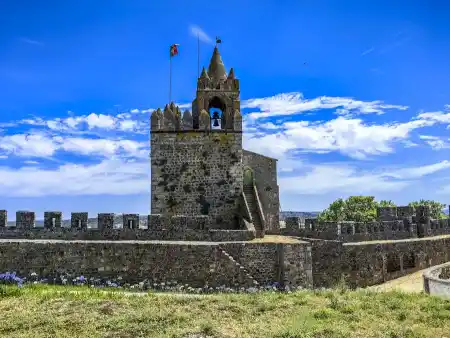
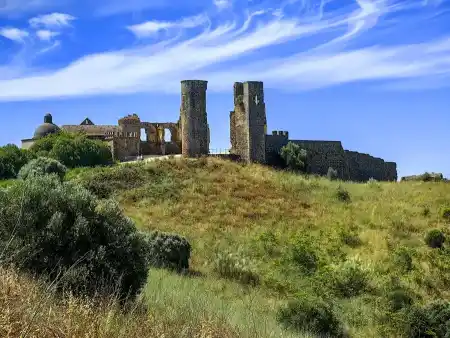
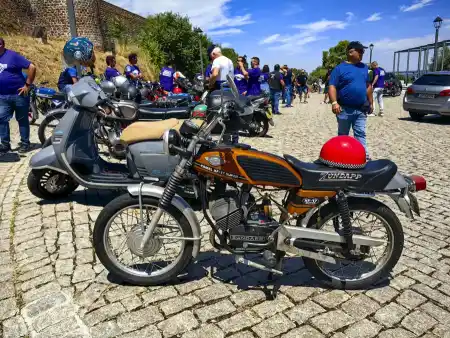
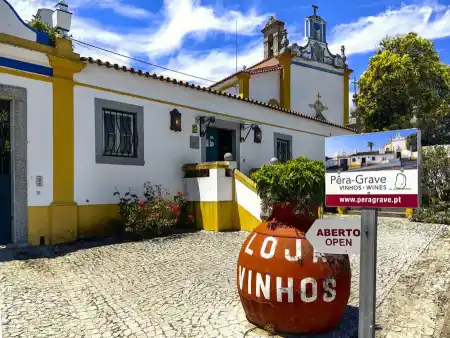

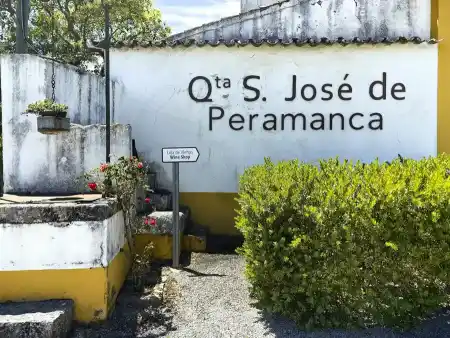
Once a year, they organise a motorbike fiesta to the castle, and we managed to capture that moment. Experienced “rent-e-car users” probably understand me. They know what it means if Europcar lends them an 8-year-old mini FIAT and charges me for excess fee 1400 euros. That’s not even what the car is worth. That’s not insurance; that’s the real inquisition.
Since we couldn’t arrange a tasting at Quinta de Plansel, we decided to stop at Quinta de São José de Peramanca for a bite.
It was a hit on uncertainty, but I can confirm again that I haven’t tasted such a great wine at such a good price in a long time. The rest of our trip was devoted to Evora itself, but that’s a separate article.
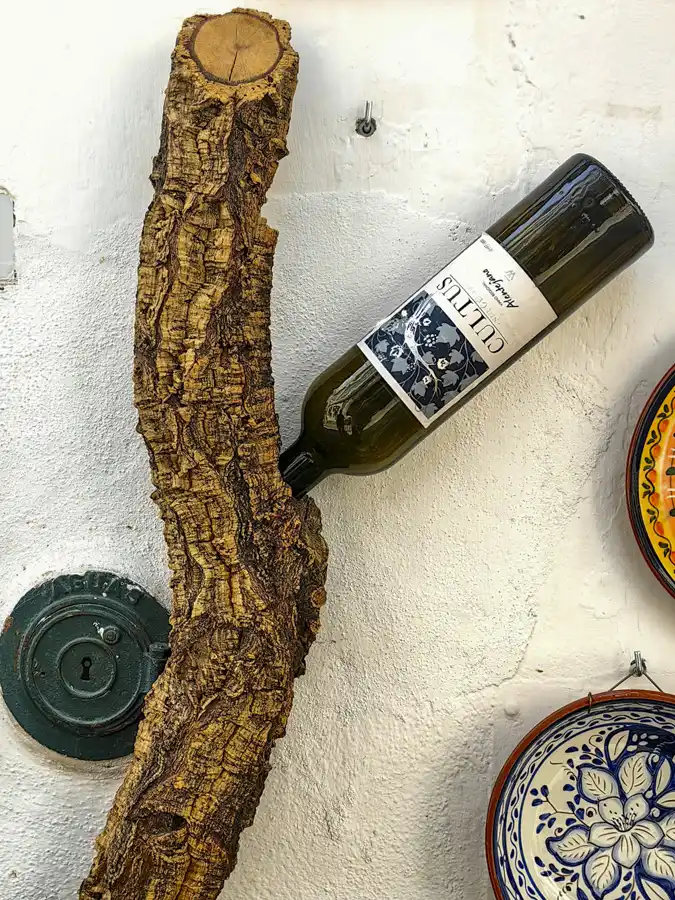
Évora
What does the centre of the Alentejo offer, and where can you get lost in the streets of Évora?
What to add in conclusion?
Alentejo is not only about wine, heritage, nature and history, but also about excellent cuisine. Local specialities include dishes such as açorda (bread with sage and garlic), migas (bread croutons with various ingredients), porco preto (black pig) and ensopado de borrego (lamb stew). These dishes are often complemented by local wines and together create an unforgettable gastronomic experience. And if anyone asks me why travel to Portugal for fine wine, our experiences are the best answer. If you love wine, authentic non-tourist experiences, unspoiled landscapes and sights, you definitely need to travel through the Alentejo wine country at least once in your lifetime.
More at photogallery >





